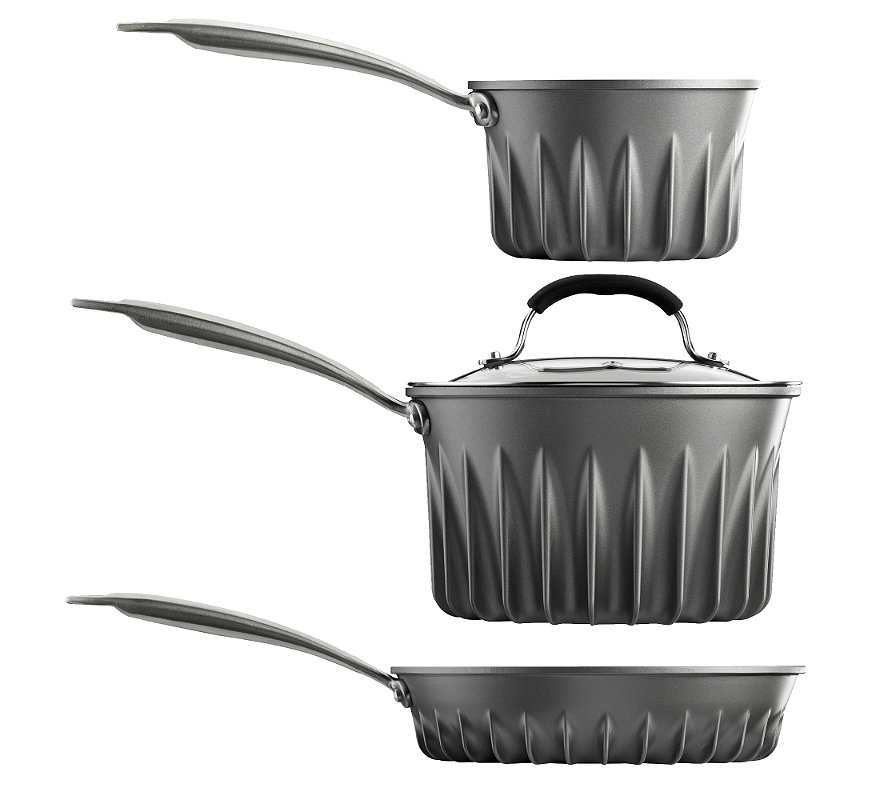UK Rocket Scientist Designs Hyper-Efficient Cookware

In recent years we've seen some neat re-thinks of basic cookware, from a self-stirring pot to Mike Whitehead's CNC-milled cast iron skillet. Now a rocket scientist from the UK, Dr. Tom Povey, has designed a line of pots and saucepans that boast astonishing efficiency.
Oxford professor Povey knows all about influencing temperature changes, as his day job in the Osney Thermo-Fluids Laboratory involves thermodynamics and jet engines. And whilst engaged in his hobby of mountain climbing, Povey ran into the problem of trying to boil water at high altitude, which takes longer than it does at sea level, burning more of the precious fuel you've hauled up the mountain. After realizing that much of the heat in conventional cooking is wasted, he set about designing a more efficient pot with this assistance of some fellow lab brainiacs.
"The problem with the current shape of [existing cookware] means a lot of the heat is dissipated into the air," Povey told The Telegraph. "So, it is an aerodynamic and heat transfer problem and we applied the science used in rocket and jet engines to create a shape of a pan that is more energy efficient."

Povey's radical-looking cast-aluminum Flare line, which UK kitchenware brand Lakeland began selling last week, employs something you see on turbines: Fins. These carry the heat from the base to the sides more efficiently, reportedly cooking food some 44% faster than a conventional pan. And a conventional pan requires 40% more energy to achieve the same results as you'd get with a Flare pan, making it ideal both for camping—less gas to carry—as well as appealing to kitchenbound consumers for both the energy savings and the evenness of the cooking.

Modest Brit that he is, Povey doesn't chalk the pan's success up solely to the design, but instead shares the credit with the manufacturer: "We've done a number of test kitchens and the chefs seem to like it, mainly down to the even heat distribution. But that is down to the good casting of the pan, as well as the product."
-
oFavorite This
-
Q5Comment
K
{Welcome
Create a Core77 Account
Already have an account? Sign In
By creating a Core77 account you confirm that you accept the Terms of Use
K
Reset Password
Please enter your email and we will send an email to reset your password.


Comments
It might make a slight difference on a gas stove. The problem is not the heat transfer from heat source to pot, since the metal pot has a high thermal conductivity anyway. The problem is the transfer from pot to water, since only a small surface area compared to its volume is in contact with the hot pot.
What made an astonishing difference in boiling time was to increase the surface area INSIDE the pot. With fins or pins or the like. But then the pot would be impossible to clean.
Well I guess you have to set yourself apart from the competition somehow...
But for those application there already exist high conduction pots and pans, usually stainless steel with a copper or aluminum layer sandwiched in between. Heck plain copper cookware works too for that.
@Toby
Do you mean magnetic induction? Because the aluminum construction of this would negate that use. In the end this is a wonderful product for anything working with an open flame, but things like induction and electrical heating elements that work through contact and magnetism would probably fair worse because of this design.
So good for busy folks with gas stoves or people camping in high altitudes, but not for anyone with an electric element or who doesn't want to scrub between all the fins.